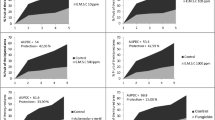Abstract
Further investigations have shown that Difolatan applications initially slow down bark renewal; however, the thickness of the living bark becomes about normal after 2 years. The previous finding that Difolatan has no direct effect on latex yield was confirmed. Evidence was obtained that the renewing bark is of normal yield capacity.
A suitable colouring agent to check the application of Difolatan is yellow iron oxide; Sterox NJ — a synthetic detergent — should be added to obtain stable suspensions.
Promising yield increase was obtained when 0.25–1% 2,4-D was added to the Difolatan suspension in water. The percentage yield increase depends not only on the 2,4-D concentration but also on the use of admixtures, which give more bulk to the 2,4-D coating on the bark. The mixtures which gave the highest yield increase caused the greatest proliferation of the renewing bark and were less effective in controlling the disease. When relatively low concentrations of 2,4-D (up to 0.25%) are mixed with the Difolatan suspension, important yield increases can be obtained without much bark proliferation or loss of fungitoxicity; such applications open up possibilities for mild stimulation of younger tress.
Samenvatting
Gebleken is dat het fungicide Difolatan, toegepast bij de bestrijding vanPhytophthora palmivora — veroorzaker van een tapvlakziekte, bekend als ‘black thread’ (Ned. naam: ‘streepjeskanker’) — aanvankelijk een remmende invloed heeft op het herstel van deHevea-bast. Echter, na enkele jaren bereikt de levende bast toch een normale dikte. Waarschijnlijk vermindert Difolatan in het begin de activiteit van het kurkcambium, waardoor minder harde bast en kurk worden gevormd. In verscheidene veldproeven werd aangetoond dat Difolatan geen effect heeft op de latexproduktie; de produktiecapaciteit van de herstellende bast zelf is waarschijnlijk ook normaal. Difolatantoepassingen op de bast worden beter zichtbaar door 1% geel ijzeroxide toe te voegen aan de waterige suspensie, welke 1% Difolatan (1.25% van het 80% spuitpoeder) en 0.1% ‘Ortho spray sticker’ bevat; in dit geval dient nog 0.01% Sterox NJ (een uitvloeier) te worden toegevoegd om een stabiele suspensie te verkrijgen.
Hogere rubberopbrengsten werden verkregen door 0.25–1% 2,4-D aan de suspensie toe te voegen. De produktie kan nog verder worden opgevoerd met behulp van hechters, die een dikkere laag residu op de bast achterlaten. De grootste produkties gingen gepaard met sterke woekering van de herstellende bast en een minder bevredigende ziektebestrijding. Evenwel, in betrekkelijk lage 2,4-D concentraties (niet hoger dan 0.25%) werden toch nog belangrijke meeropbrengsten verkregen zonder noemenswaardige bastwoekering of een sterke teruggang in fungitoxische eigenschappen van het mengsel. Deze formuleringen bieden mogelijkheden voor een milde stimulatie van jongere bomen, terwijl tegelijkertijd de ‘streepjeskanker’ wordt bestreden.
Similar content being viewed by others
References
Anliker, W. L. & Scanlon, D. H., 1965. Evaluation of a technique for stimulating yield ofHevea brasiliensis. Expl. Agric. 1: 153–160.
Chee, K. H., 1969. Leaf fall due toPhytophthora botryosa. Plrs' Bull. Rubb. Res. Inst. Malaya 104: 190–198.
Jonge, P. de, 1957. Stimulation of bark renewal ofHevea and its effect on yield of latex. J. Rubb. Res. Inst. Malaya 15: 53–71.
Levandowsky, D. W., 1960. Clonal variations in yield and bark regeneration ofHevea brasiliensis after yield stimulation. Proc. nat. Rubb. Res. Conf., Kuala Lumpur: 270–288.
Puddy, C. A. & Warriar, S. M., 1960. Yield stimulation ofHevea brasiliensis by 2,4-dichlorophenoxy-acetic acid. Proc. nat. Rubb. Res. Conf., Kuala Lumpur: 194–210.
Schreurs, J., 1969. Difolatan, a promising fungicide for control of the tapping panel disease black thread inHevea brasiliensis. Neth. J. Pl. Path. 75: 113–118.
Sharp, C. C. T., 1937. Experiments with economic tapping systems. J. Rubb. Res. Inst. Malaya 8: 24–38.
Author information
Authors and Affiliations
Rights and permissions
About this article
Cite this article
Schreurs, J. Control of black thread (Phytophthora palmivora) in hevea brasiliensis with Difolatan. Netherlands Journal of Plant Pathology 77, 113–126 (1971). https://doi.org/10.1007/BF02000551
Accepted:
Issue Date:
DOI: https://doi.org/10.1007/BF02000551




